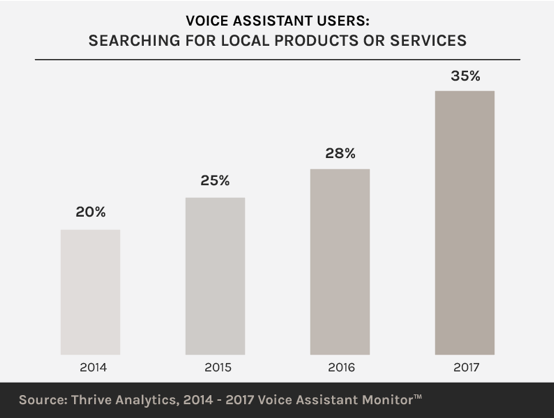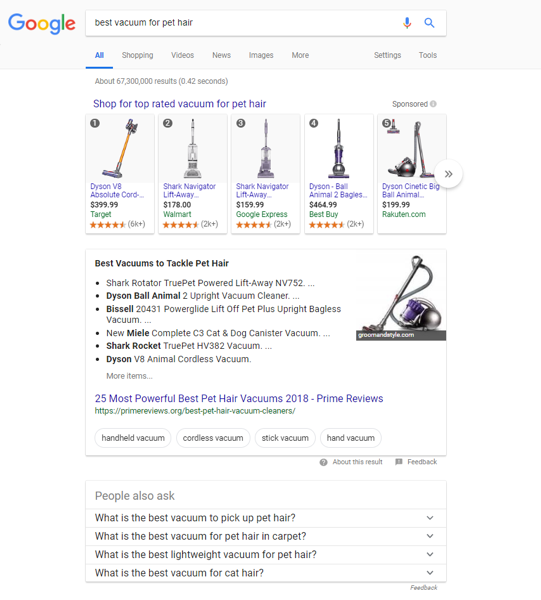As long as you evolve the way you create and distribute your content and keep pace with trends, content marketing will continue to be an authentic, useful, and engaging method that gets results. At the end of the day, it’s easier to talk than type and people will speak more and more to Google Assistant, Alexa, Siri, and tap the microphone to talk into the Google search bar in the years to come. Take the conversational nature of voice searches into consideration during keyword research. Marketing to the masses It can be tempting, and even common practice, to create one-size-fits-all marketing strategies. The effort to personalize can make your brand stand out and gain trust with your audience: Personalized account-based marketing led to four times more conversions than generic marketing in a Salesforce study. The value of personalized content is the reason more marketers recognize the opportunities in content marketing, influencer marketing, and other methods that deliver what their audience members need or want. You can then put the data to work in many ways (just don’t creep them out by getting unnecessarily personal): Personalize calls to action in your content and on your site. Ignoring Privacy Protections Given that you’re collecting data for personalization, you also should be thinking about privacy regulations, right? It’s easier than you think to get started: Ensure that your privacy policy includes definitions and disclosures about cookies, third-party data collection (e.g., Google Analytics) and other information your site collects on visitors. Write short, engaging posts.

With 2019 coming in hot, don’t find yourself out of the loop using techniques that will hurt your marketing efforts, or worse, cause a mass extinction of ROI. Things are changing fast and it can be hard to differentiate while maintaining a sense of trust with your audience.
First, you can let out a sigh of relief because two things will remain constant:
- Content marketing will be important, even more so than this year.
- Content creation and distribution will continue to change.
As long as you evolve the way you create and distribute your content and keep pace with trends, content marketing will continue to be an authentic, useful, and engaging method that gets results.
So what are some trends to avoid in 2019?
1. Focusing solely on typed search queries
Typed searches may be on the endangered list as conversational commerce rises. People are searching differently. Nearly 50% of Americans use voice assistants. Voice already prompts one of every five Google searches on mobile devices, and analysts are not only predicting this to increase, they’re harping that a world with screen-less searching is around the corner.
It makes sense. As younger generations grow up using voice-responsive devices and search capabilities, talking, not typing, becomes the norm. One study shows 71% of 18- to 28-year-old adults use voice assistants compared to 39% of people ages 44 to 53. Plus, other research shows that between 2014 and 2017 the number of people using voice search to find a deal, local product, or service increased 75%.
The other day, I saw a Bose headphone commercial that featured a young woman on a crowded bus telling her headphones to add bananas to her shopping list. Talking to yourself in public is rapidly losing its stigma. At the end of the day, it’s easier to talk than type and people will speak more and more to Google Assistant, Alexa, Siri, and tap the microphone to talk into the Google search bar in the years to come.
What to do in 2019
The way people speak into a phone is different from the way they type in a search bar. Search queries need to match natural language. Instead of competing for keywords, you may want to consider targeting long-tail sentences people are likely to say when they search. In short, you should answer questions the way a human being would. Also, keep these tips in mind:
- Use longer natural phrasing in your titles and headers.
- Take the conversational nature of voice searches into consideration during keyword research.
- Optimize natural language content to appear on top if you’re investing in “near me” searches.
- Use structured data, site links, and rich snippets to help Google provide the right answer people are searching for.


2. Relying on traditional video
In 2016, it became clear that videos, GIFs, and animations were the key to grabbing attention in a news feed filled with copy and static images.
Looking forward to 2019, movement is still key to grabbing the wandering eye, but videos don’t have to be planned or scripted. In fact, they shouldn’t be. Live video is on the rise for a hungry audience that wants to be in the moment with their favorite brands. It can be more candid, honest, and most importantly, fun. When you think about it, watching a recorded video means you’re always watching the action after it happens.

A survey by Livestream found that 82% of respondents would rather tune in to a brand’s live video than read its social media posts. YouTube, Facebook, and Instagram’s live video services had a huge impact this year, with 64% of consumers saying that watching a Facebook video…

COMMENTS